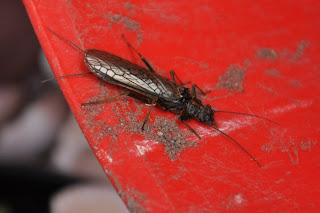May wildlife sightings from a garden in Annan
The birds have been very busy this month - as you might expect! Pairs of birds have been around together in the garden and then one is seen more often than the other as the female is sitting on eggs. Then both birds appear again as they feed young chicks. We have seen blackbirds, blue tits, great tits, dunnock and sparrows all very busy with their families. The jackdaws have become more daring this month too - actually working out how to get the seed from the bird feeder that hangs in a tree (despite it having chicken wire around it to stop larger birds getting to it!) on 19/5/16
We saw the first swift of the year this month too - on 4/5/16
Blackbird - 3 male, 1 female. Seen taking worms into hedge 3/5/16
Blue tit - 2
Buzzard - 3
Carrion crow - 2
Coal tit - 1
Collared dove - 2
Dunnock - 1
Goldfinch - 2
Great tit - 2 in & out box feeding 8/5/16, young fledged 29/5/16
House sparrow - 20 male, 20 female
Jackdaw - 5
Pied wagtail - 1
Siskin - 1 male, 1 female
Starling - 13
Swallow - 4
Swift - 20
Woodpigeon - 4
Bees have been increasing in numbers this month too. Even on the days it has been quite windy they are still busy buzzing around the early flowers. We have also seen our first ever Tree Bumble Bee in the garden this month - 19/5/16
Solitary bees are appearing and we have put out blocks with holes drilled in them for them to nest in. Amazingly they were quickly occupied by the bees!
Early Bumble Bee - 1
Garden Bumble Bee - 1
White-tailed Bumble Bee - 2
Buff-tailed Bumble Bee - 2
Red-tailed Bumble Bee - 2
Tree bumble bee - 1
Honey Bee - 2
Red mason bee - 1
Unfortunately there have been very few sightings of butterflies or ladybirds this month -
Green-veined white butterfly - 1
Small tortoiseshell butterfly - 1
2 spot ladybird - 1
7 spot ladybird - 1
However we did find something we had never seen before! While weeding we found a stonefly.
Since then we have seen others on walks - and been pleased to be able to identify them!
After more than a year we have also seen a hedgehog in the garden again - 29/5/16. We were out moth trapping and heard rustling in the bushes and there he was wandering along one of the borders.
Moth trapping has gradually improved this month although still not the numbers we might have expected. A maximum of only 39 moths at any one time.
DGERC Things to look out for in June:-
The Common Pelican's Foot is a distinctive shell to look for on beaches around the D&G coast. The shell is usually glossy and sandy/creamy in colour, reaching up to 4cm long with up to ten whorls. As it matures, the final whorl fans out into 5 blunt points, resembling the webbed foot of a waterbird. The animals live below the low tide water level in the sublittoral zone on mud or muddy sand.
Spotted Flycatchers are one of the last summer migrants to arrive. They are robin-sized, though a little sleeker in build, grey-brown in colour with a streaked breast and crown. Though their appearance is relatively understated they are wonderful birds to watch, perching on a branch waiting for passing insects which they catch on the wing before returning often to the same perch. They can be found in gardens, churchyards, cemeteries and parks as well as woodland with open glades. Nationally their numbers have declined by 80-90% since the late 1960's.










Comments
Post a Comment